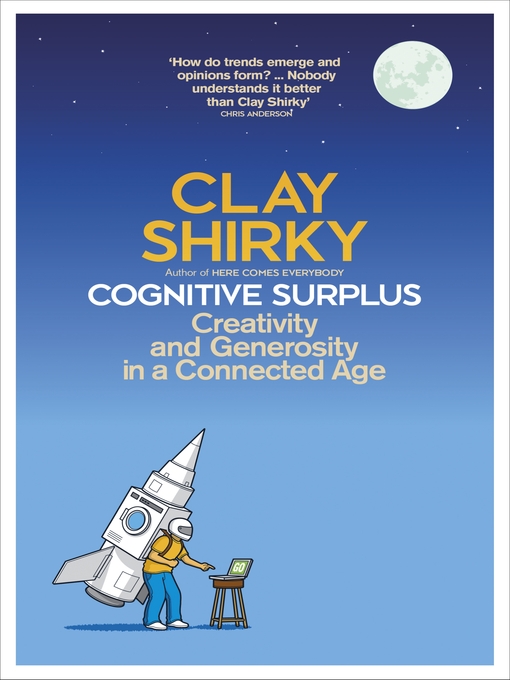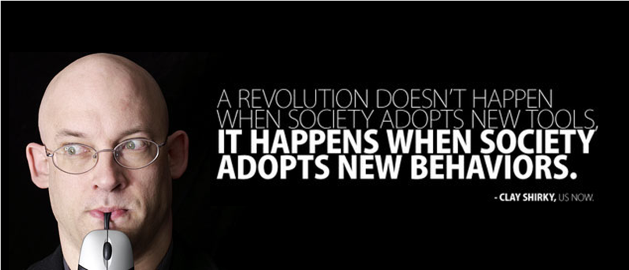Book Review: Cognitive Surplus by Clay Shirky
In previous years of this so called “new world”, criticizing the Television became a common thing. The critics are well founded since only in the U.S, 200 billion hours per year are spent in front of a TV. For Clay Shirky, the content of what you see on television doesn’t matter, what matter is the time you spend in an only consumable system that don’t allow you to interact or produce. For better understanding, Shirky draws a parallel with new civic models. Beginning with the Gin Craze in 18th century until television nowadays, they are ways that people find to fill their free time and fit into society.
 But what happens when the numbers of hours watching TV begin to decrease? Children now dedicate more time on internet and mobile phones than being couch potatoes. It’s time for another civic model. We still continue to have free time but we are choosing to achieve the entire media tripod: consume, produce and share. According to Shirky, now we have the means, motives and opportunities to do that, and this free time, plus new media is what Clay Shirky defines as “Cognitive Surplus”.
But what happens when the numbers of hours watching TV begin to decrease? Children now dedicate more time on internet and mobile phones than being couch potatoes. It’s time for another civic model. We still continue to have free time but we are choosing to achieve the entire media tripod: consume, produce and share. According to Shirky, now we have the means, motives and opportunities to do that, and this free time, plus new media is what Clay Shirky defines as “Cognitive Surplus”.
In this book, the author explains what allows us to use our cognitive surplus, the kinds of contribution we can create and how we can improve the odds of a good social media. Meanwhile, the author does these with a light and engaging writing, providing facts, examples and concepts.
“This book is about novel resource and about ways of society might take advantage of it”.
The middle chapters of the book are dedicated to clarify what allows us to use our cognitive surplus: means, motive and opportunity. Means are what technology provides, ways to find each other, to coordinate in a global level that wasn’t possible a few years ago. This can be used in a simple carpooling as PickUpPal.com or to change a Government decision as the girl’s protest about American Beef in North Korea. However, is not just technology that improves our participation, we also need motive to do such things. In a psychological approach, our motivations are divided between intrinsic – when the reward is the activity itself – and extrinsic – when the reward is something else, usually money. In our society we see extrinsic motivations everywhere, work is the biggest one. The intrinsic motivations appear more on hobbies; they are something you love to do. Clay Shirky’s proposal is that we use our intrinsic motivations for sharing something with the community. He illustrates that with the Grobanites for Charity, a group of Josh Groban’s fans that raises money for charity and donated them in the singer’s behalf. They had the means, the community inside Groban’s site, and they had the motive, the love for the singer and his supportive causes. They were using what Clay Shirky calls “social motivations”, the sense of membership – be part of something – and generosity – give something back.
Nevertheless, those girls and women’s work wouldn’t exist if weren’t for the opportunity to be in a large community equal in the love for this singer. This is the opportunity that Clay Shirky discusses. The opportunity to be in an intrinsic rewarded motive enabled by technology created by humans. He also sees that as the natural way of things, people seek for social communication; we just have to enable that.
In other to really understand what we can do with our cognitive resources, the author brings our attention to culture. This is what will distinguish the use of “free time” in a merely personal or in a civic way. As the same way that Clay Shirky does in his lecture for TED, he presents a parallel between LoLCats – the site for sharing pictures of cute cats with misspelled captions – and Ushahidi – the software platform for information collection that began warning spots of violence in Kenya. Both sites have sharing value; you can complete the media tripod: produce – consume – share. But one is just personal, doing something funny, and the other has civic value. Clay Shirky expands these values in two more as he calls “The four spectrum of sharing cognitive surplus”.
Personal: A group of uncoordinated individual as LoLCats.
Communal: A group of collaborators as PickUpPal.
Public: Creates public resource as Open Source Software.
Civic: Tries to change society as Ushahidi.
According to Clay Shirky, the first two values of the spectrum already exists in a large scale and are more probably to stay for a long time because just depends on one person or an uncoordinated group. The bottom of the spectrum, however, is where the challenge begins, since it needs coordinated and focused persons willing to accomplish something good for society. This is what this book is all about; it’s a wake-up call to social participation. With means, motive and opportunity we can choose to use our cognitive surplus in public and civic ways, creating more value for society, turning life better.
“Those things [new media and cognitive surplus] make me believe that the kind of participation we’re seeing today, in a relative handful of examples, is going to spread everywhere and to become the back-bone of assumptions about how our culture should work”.
Many readers will think this is a very optimistic even naive view of society. Well, of course you can choose to use your cognitive surplus for doing something bad, or not doing anything at all, but we have enough examples that demonstrate that people want to collaborate with something when the opportunity in given to them. As a researcher on the effects of the Internet on society, as he self-proclaimed, Clay Shirky is attending us to the shift in our media environment, more than ever, we have a chance to be producers instead of just consumers. The radius and half-life of groups are increasing and every household has a chance to turn global.
Lastly, you can choose to use you cognitive surplus in the best way you can. You can choose doing something as demanding as Wikipedia, something funny as LoLCats or something that can help people in a needed time as CLOO’.
